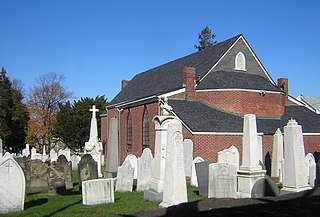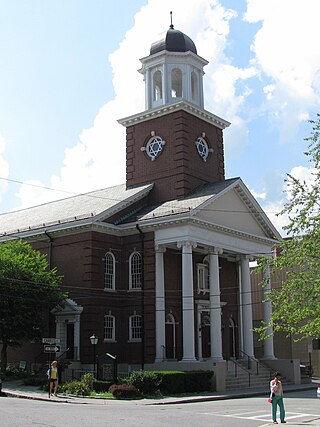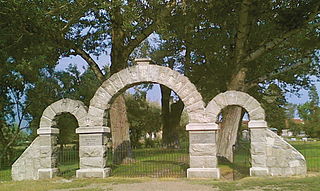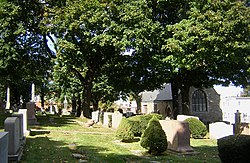
Orient Heights is a historic section of Boston, Massachusetts, United States, and is commonly considered part of East Boston; it is Boston's northernmost and northeasternmost neighborhood.

Holyhood Cemetery is a cemetery located in Brookline, Massachusetts.

Touro Synagogue Cemetery, dedicated in 1677, is located in the colonial historic district of Newport, Rhode Island, not far from the Touro Synagogue. Other Jewish graves are found nearby as part of the Common Burying Ground and Island Cemetery on Farewell Street.

Temple Freda, built in 1912, is a former synagogue in Bryan, Texas, in the United States. The building was added to the National Register of Historic Places on September 22, 1983.

The United Hebrews of Ocala is an historic former Reform Jewish synagogue building located at 729 N.E. 2nd Street, in the Tuscawilla Park Historic District of Ocala, Marion County, Florida, in the United States.

Saint Augustine Chapel and Cemetery is a historic church on Dorchester Street between West Sixth and Tudor Streets in the South Boston neighborhood of Boston, Massachusetts. Built in 1818–19, it is the oldest Roman Catholic church building in Massachusetts; the cemetery, established 1818 is also the state's oldest Catholic cemetery. The Gothic Revival chapel was originally built as a crypt for the remains of Father François Matignon, the first Catholic priest to come to Boston from France. Father Dennis J. O'Donovan and many other priests are also buried there.

Congregation Agudath Shalom, also known as Agudas Sholom the Walnut Street Synagogue or the Walnut Street Shul, is an historic Open Orthodox Jewish synagogue located at 145 Walnut Street in Chelsea, Massachusetts, in the United States.

Beth Israel Synagogue is a historic former Jewish synagogue building at 238 Columbia Street in Cambridge, Middlesex County, Massachusetts, in the United States. Built in 1903, it was the first and principal synagogue to serve the East Cambridge area, and is a fine local example of Romanesque Revival architecture. Now converted into residential condominiums, it was listed on the National Register of Historic Places in 1982.

Temple Ohabei Shalom is a Reform Jewish synagogue located at 1187 Beacon Street, in Brookline, suburban Boston, Massachusetts, in the United States. Organized in 1842 with membership mainly of German Jews, it is the oldest Jewish congregation in Massachusetts and the third oldest in New England, following congregations in Newport and New Haven.

Temple Israel Cemetery is a historic Jewish cemetery on North Avenue in Wakefield, Massachusetts. The cemetery was established by the Temple Israel congregation of Boston in 1859. Unlike the adjacent Lakeside Cemetery, whose landscape is of winding paths, this cemetery is laid out in a rectilinear grid. Stones are somewhat uniform in their content, often listing places of birth and death. Markers placed early in the cemetery's history are predominantly marble, while many of those placed in the 20th century are granite or limestone. The cemetery's most notable burial is that of Rabbi Joshua Liebman.

The Mystic River Jewish Communities Project is a non-profit organization dedicated to preserving the heritage of the Mystic River Jewish communities of Chelsea, East Boston, Everett, Malden, Medford, Revere, Somerville, and Winthrop, Massachusetts.

The Eastside Historic Cemetery District is a historic district bounded by Elmwood Avenue, Mt. Elliott Avenue, Lafayette Street, and Waterloo Street in Detroit, Michigan. The district consists of three separate cemeteries: Mount Elliott Cemetery, Elmwood Cemetery, and the Lafayette Street Cemetery. The district was listed on the National Register of Historic Places in 1982.

Clarence Howard Blackall was an American architect who is estimated to have designed 300 theatres.

The Second Unitarian Church is a historic church and synagogue building at 11 Charles Street in Brookline, Massachusetts. Built in 1916 for a Unitarian congregation, it was acquired by the innovative Reform Jewish Temple Sinai congregation in 1944. It is a high quality example of Colonial Revival/Georgian Revival architecture, and was listed on the National Register of Historic Places in 1985.

Home of Peace is a Jewish cemetery in Helena, Montana, founded in 1867 by the local Hebrew Benevolent Society, which formed on December 9, 1866. The Society formally purchased the land in 1875. The Home of Peace Cemetery Association now maintains the grounds. It is the oldest active cemetery in Helena and the oldest active European ethno-religious cemetery in Montana. There are three major sections of land owned by the Association: the cemetery, undeveloped adjacent land, and land leased to the Helena School District since 1975. The portion leased by the school district is a practice football field for Capital High School and contains unmarked graves from the earliest days of the cemetery. The original wrought iron fence erected in 1867 still stands except on the north side and is in disrepair in places. A granite gateway erected in 1910 is at the main entrance. The east gate also has granite markers. There is a water tower, pump house, and landscaping shed. Twelve broken tombstones lie at the base of the water tower. The northwest corner has remained undeveloped and in its natural wild state. In 1910 cottonwood trees were planted along the driveway.

Temple Beth Israel is an historic former Orthodox and Conservative Jewish synagogue building, located at 39 Killingly Drive in the Danielson village of Killingly, Connecticut, in the United States.
Raphael Lasker was a German-born American rabbi in Ohio, New York City, and Boston.

Isaac Rosnosky was a Prussian-born Jewish-American businessman and politician from Boston. He was the first Jew to be elected to the Boston City Council or the Massachusetts state legislature.























